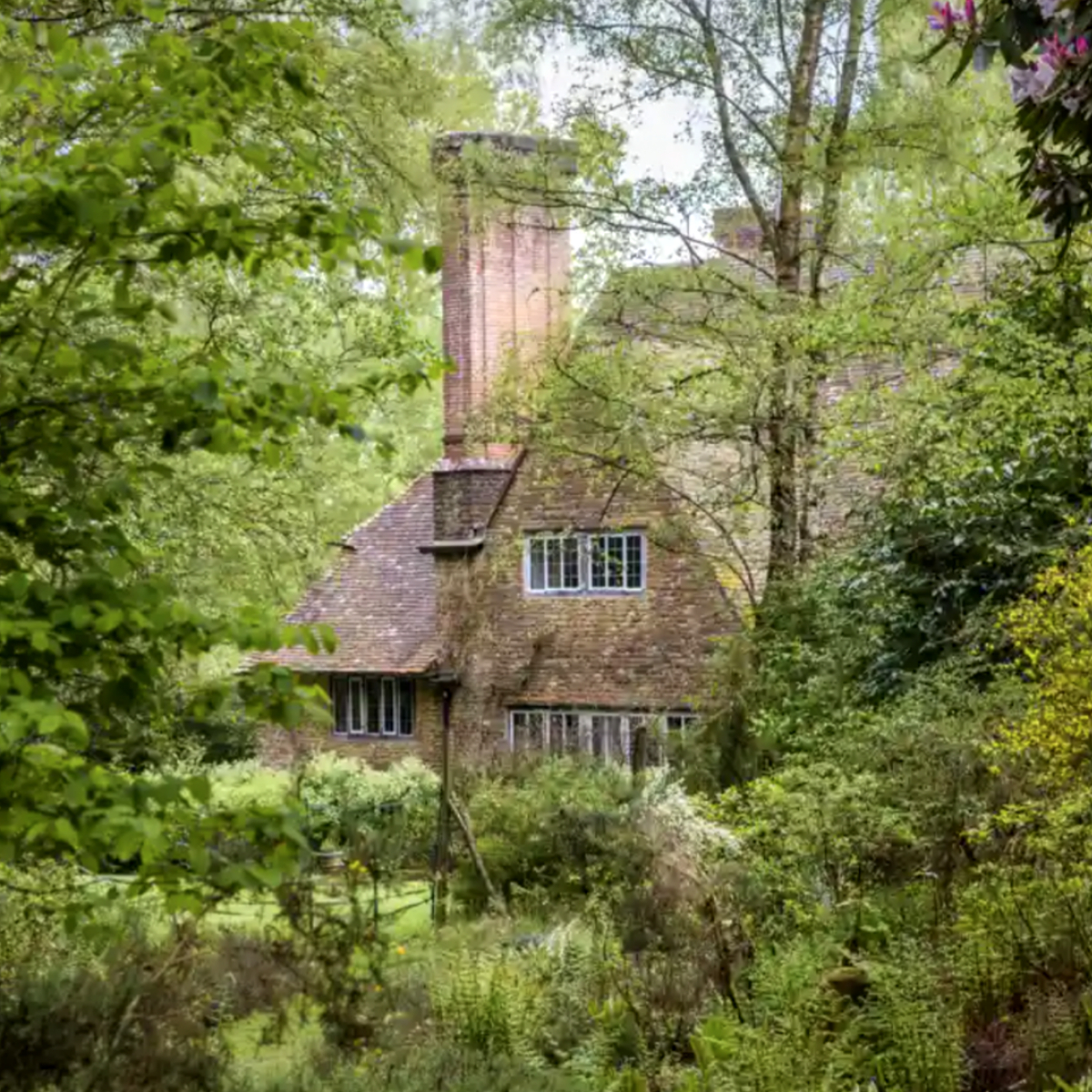However much Gertrude Jekyll is usually described as a garden designer and horticulturist, she was first and foremost an artist and Munstead Wood, her house near Godalming in Surrey, is the most wonderful expression of her extensive talents. So, the announcement of the acquisition by the National Trust of her garden together with the house designed for her by Edwin Lutyens, is tremendously exciting and ensures that this exceptional property is brought into the public domain and secured for future generations. In a quiet corner of Surrey, this house and garden represent one of the most influential partnerships in the Arts and Crafts movement: that between Jekyll and Lutyens.
At Munstead Wood, unexpected vistas and pictorial surprises are revealed around the house: from primrose strewn woodland walks to rambling roses, complex herbaceous borders and towering rhododendron corridors. In a house that Lutyens designed in close collaboration with her, Jekyll created – as a skilled craft worker in her own right – intricate wood carvings, iridescent shell inlays, repoussé metalwork and delightful ceramic tiling. The sprits of John Ruskin and William Morris are everywhere and as much as with her decoration within the house Jekyll’s painterly style of planting, her characteristic informal schemes complementing a formal framework, can be admired through the lens of what she called ‘useful beauty’.
Gertrude Jekyll was born in November 1843, the fifth of seven children within a conventional Victorian family, with her father a captain in the Grenadier Guards. In early childhood the family moved to Surrey, south of London, and Gertrude’s life was much associated with this county. After school she enrolled at the South Kensington School of Art, and later attended evening classes at the Slade School, through which she absorbed the growing influence of the arts and crafts movement. With the support of her family, she might have continued to work as a fine artist but became absorbed in learning a variety of craft skills from embroidery and quilting to inlay, wood carving and metalworking (later being trained as a blacksmith) and initially took up design and when she started professional work it was offering advice on furnishings and interior design.
![Gertrude Jekyll, fireplace design, Munstead Wood [photo Sandy Nairne]](https://artsandcraftstours.com/wp-content/uploads/gertrude-jekyll-fireplace-design-munstead-wood.png)
However, Gertrude’s poor eyesight took her away from art and towards an interest in plants and the design of gardens. She had opportunities to travel to Italy and to Algeria and she started to collect plants that would form part of her planting schemes as well as contributing to establishing a garden nursery business. After her father died in 1876, her mother commissioned a new family home in Surrey, Munstead House, and invited Gertrude to design the gardens. By this time, Gertrude was much taken with the ideas of William Robinson – who had published The Wild Garden in 1870 – and through the garden design for Munstead House, where she lived with her mother, she began to be recognised as a gifted horticulturalist and designer.
In 1882 the opportunity arose to acquire 15 acres of woodland over the lane from Munstead House, and Gertrude’s plan for this purchase (made by her mother) was to breed new plants and establish a garden nursery. In 1889 Jekyll met Edwin Lutyens and was very taken with this brilliant young architect still in his 20s. In the same year she commissioned him to design her a substantial house, which was constructed in 1896-7 and called Munstead Wood. Along the way he created a temporary home for her, named The Hut in 1894-5, and designed a cottage for her gardener in the same years together with stables and outbuildings, all of which survive, although now in separate private ownership.
![Munstead Wood by Edwin Lutyens, 1896-7 [photo Sandy Nairne]](https://artsandcraftstours.com/wp-content/uploads/munstead-wood-by-edwin-lutyens-1896-7.png)
Munstead Wood became a place of experimentation, craft, and beauty: a living collection, embodying one of the greatest of contributions to horticulture, to architecture, and to culture more broadly. In the 1880s Gertrude Jekyll had taken up photography (Lutyens designed a dark room for her in the cellar, which survives, along with a special back door and shelving by which local people could come and buy seeds or cuttings) and used photographs to illustrate the many articles she contributed to the newly established Country Life, and other magazines and newspapers, and her many books which helped change the course of garden design in Britain and around the world. Wood and Garden of 1899 was very much based on her work at Munstead Wood, and this special place, compared by some to Claude Monet’s Garden at Giverny, remained the centre of her world until her death in 1932.
Gertrude Jekyll created about 400 gardens across Britain, Europe and America, collaborating with Lutyens on many projects. Notable surviving gardens include Upton Grey, Hestercombe and Lindisfarne Castle, and Vann and Goddard’s in Surrey. In 1897 she was the first woman to be awarded the Royal Horticultural Society’s Victoria Medal of Honour – the highest award for British horticulturists. However, the great majority of her gardens have not survived, which gives greater importance to those that have.
When the National Trust acquisition was announced, Andy Jasper, the Trust’s head of gardens and parklands, commented that: ‘Before Jekyll, late Victorian gardens were formal, almost regimented places … Jekyll started using plants like a painter would use a palette of oil paints. You start to see a sense of theatre and showmanship and delight.’ Jasper described how she created areas ‘like a series of rooms’ to flower in different seasons, ‘so there was always something to see. She really played with colour. She used very strong, bright colours in the foreground, and then more muted shades at the rear, to create a sort of foreshortening so you imagine the borders were much deeper than they were.’ He went on to say that Munstead Wood was ‘not only a rare surviving example of Jekyll’s work, it is also the garden where she developed and clearly expressed her ideas … and the source of the planting experiments she described in her writing, the hub of her garden design and nursery business and had a huge influence on garden design and planting not just in Britain but internationally … There is no greater example of a classic English garden.’
![Border at Munstead Wood, July 2022 [photo Sandy Nairne]](https://artsandcraftstours.com/wp-content/uploads/border-at-munstead-wood-july-2022.png)
Luckily, much of the original design and planting survives at Munstead Wood, and in the woodland garden her approach to an idea of ‘wild gardening’ is particularly evident. Most of the paths, walls and a small pond and paving near the house are in place and some years ago Jekyll’s rock garden (which had been buried under layers of debris) was rediscovered. In the 1950s the garden had been simplified, but Sir Robert and Lady Clark, owners for many recent decades, did a great deal to restore the design and planting by Jekyll. There is much material in the way of photographs, planting plans, written descriptions and paintings which will guide the Trust in the renewal of the garden and house.
When, in 2022, Munstead Wood was placed on the open market it became clear that if the National Trust did not purchase the property quickly, public access to this extraordinary garden and house could be lost forever. Jekyll shared the magic of Munstead Wood for the joy it brought, and today the National Trust has the opportunity to try and extend that, with substantial funds required to renew and revitalise the garden and conserve the house for the long term. Consultations are now taking place about public access (permission for ‘change of use’ will be required, which may take some time) and how the garden and house can best be managed in the future.
If you would like to learn more about the conservation and renewal project and how you might contribute to the future of Munstead Wood, please contact the General Manager, Katherine Mills: katherine.mills@nationaltrust.org.uk
The survival of both house and garden offers an extraordinary chance to tell the story of the house and garden, and Jekyll’s enormous impact, inspiring a new generation of gardeners and nature lovers.
Hilary McGrady, Director General, National Trust, 2023
The lesson I have thoroughly learnt and wish to pass on to others, is to know the enduring happiness that the love of a garden gives.
~ Gertrude Jekyll ~
About the author
Sandy Nairne is a curator and writer and currently deputy chair of the National Trust. From 2002 to 2015 he was director of the National Portrait Gallery and previously director of programmes at Tate. He is chair of the Fabric Advisory Committee at St Paul’s Cathedral and an advisor on art for Maggie’s cancer care centres. His previous books include Art Theft and the Case of the Stolen Turners, 2011, and forthcoming is a co-authored biography of Lord Desborough entitled Titan of the Thames. He is a Fellow of the Society of Antiquaries and he was appointed CBE in 2011.


